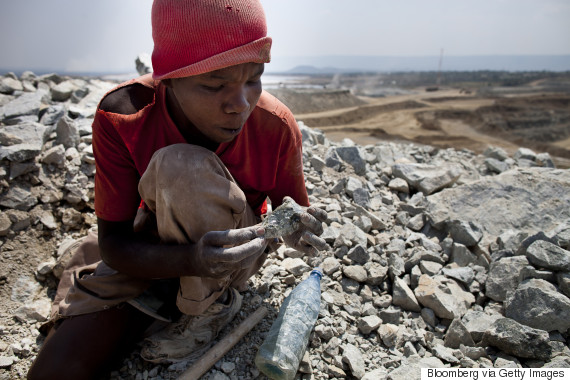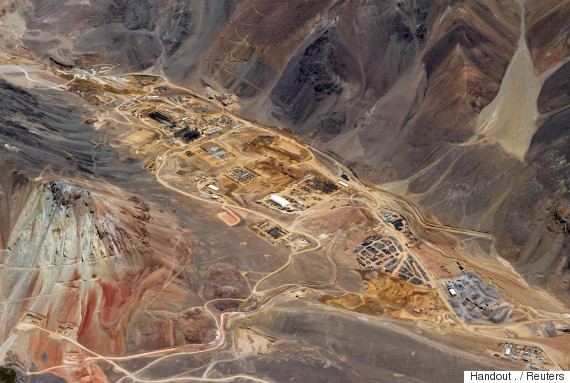
A villager searches for gold in discarded waste rock from Barrick Gold Corp’s North Mara mine in the district of Nyangoto, Tanzania. Millions of pounds of waste rock are piled high around communities where almost half the people live on less than 33 cents a day. (Photo: Trevor Snapp/Bloomberg via Getty Images)
Significant sums in Canadian “aid” are spent promoting international mining initiatives.
In a press release last week, Ontario-based Carube Copper said it acquired “over 500 square kilometres of the most prospective ground in Jamaica based on historic showings, the work completed and reported in 1993 by the Canadian International Development Agency (‘CIDA’).”
Canadian aid has facilitated similar work elsewhere. Researching Canada in Africa: 300 Years of Aid and Exploitation I discovered examples of Ottawa funding the collection of geological data in Tanzania, Angola, Cameroon, Niger, Uganda, Kenya and elsewhere. Long-time West Africa-based freelance journalist Joan Baxter describes a chance encounter with Canadian geologists in her 2008 book Dust From Our Eyes: an Unblinkered Look at Africa:
“Another CIDA employee I met one evening in Bamako [Mali] told me his work with CIDA had been a long-term project to map the mineral resources of Zaire, now the Democratic Republic of Congo. When we spoke, he was on a two-year sabbatical from CIDA, working with Canadian mining companies that had taken out concessions in that country.”
Ottawa has financed various mining-related educational initiatives. CIDA sponsored the Zimbabwe School of Mines, a mid-1990s government-industry collaboration, and financed a Senegalese school for geomatics (combining geography and information technology to map natural resources), which received an added $5 million in 2012.
In 2014 Ottawa announced $12.5 million for the Project Strengthening Education for Mining in Ethiopia “to develop more industry driven geology and mining engineering undergraduate programs” at Ethiopian universities. In 2012 CIDA put up $25 million for the Canadian International Institute for Extractive Industries and Development (CIIEID), a university-hosted think tank, which International Development Minister Julian Fantino told a Mining Association of Canada meeting would “be your biggest and best ambassador.”
In the most significant boon to international mining firms, Canadian aid has helped liberalize mining legislation.
While mining education and geological data collection indirectly benefit Canadian mining companies, millions of dollars have been ploughed directly into corporate social responsibility projects. One example was a $4.5-million grant to Lundin for Africa, the philanthropic arm of mining giant Lundin Group of Companies, for its operations in Ghana, Mali and Senegal, and Ottawa also put up $5.6 million for a project between NGO Plan Canada and IAMGOLD near the company’s mine in Burkina Faso.
These aid projects are often about mollifying local opposition to mining projects. In 2012 CIDA invested $500,000 in a World Vision Canada/Barrick Gold project in Peru described as “tantamount to running a pacification program” while between 2003 and 2005 Calgary-based TVI Pacific dispersed tens of thousands of dollars in Canadian aid money to a community opposed to its mine on the Philippine island of Mindanao.

The gold processing plant under construction in Argentina at Barrick Gold’s Pascua-Lama mine site. (Photo: REUTERS/Barrick/Handout)
In the most significant boon to international mining firms, Canadian aid has helped liberalize mining legislation. Authors of Imperial Canada Inc.: Legal Haven of Choice for the World’s Mining Industries, Alain Deneault and William Sacher, cite Botswana, Zimbabwe, Guinea and Zambia among the countries where Canadian aid has shaped mining legislation.
Gwendolyn Schulman and Roberto Nieto write: “Canadian cash, technocrats and know-how have also been involved in rewriting mining codes in Malawi, Ghana, Mali and the Democratic Republic of Congo (with, in this last case, civil war as a backdrop).”
In the best documented example, Ottawa began an $11-million project to re-write Colombia’s mining code in 1997. CIDA worked on the project with a Colombian law firm, Martinez Córdoba and Associates, representing multinational companies, and the Canadian Energy Research Institute (CERI), an industry think-tank based at the University of Calgary. The CIDA/CERI proposal was submitted to Colombia’s Department of Mines and Energy and became law in 2001.
“The new code flexibilised environmental regulations, diminished labour guarantees for workers and opened the property of Afro-Colombian and indigenous people to exploitation,” explained Francisco Ramirez, president of SINTRAMINERCOL, Colombia’s State Mine Workers Union. “The CIDA-backed code also contains some articles that are simply unheard of in other countries,” added Ramirez. “If a mining company has to cut down trees before digging, they can now export that timber for 30 years with a total exemption on taxation.”
The new code also reduced the royalty rate companies pay the government to 0.4 per cent from 10 per cent for mineral exports above 3 million tons per year and from five per cent for exports below 3 million tons. In addition, the new code increased the length of mining concessions from 25 years to 30 years, with the possibility that concessions can be tripled to 90 years.
“Aid” has helped Canada’s companies dominate a global mining industry often mired in conflict and criticized for providing meagre benefits to local communities. It’s hard to understand why this would be considered “aid.”
Follow HuffPost Canada Blogs on Facebook
Also on HuffPost:










